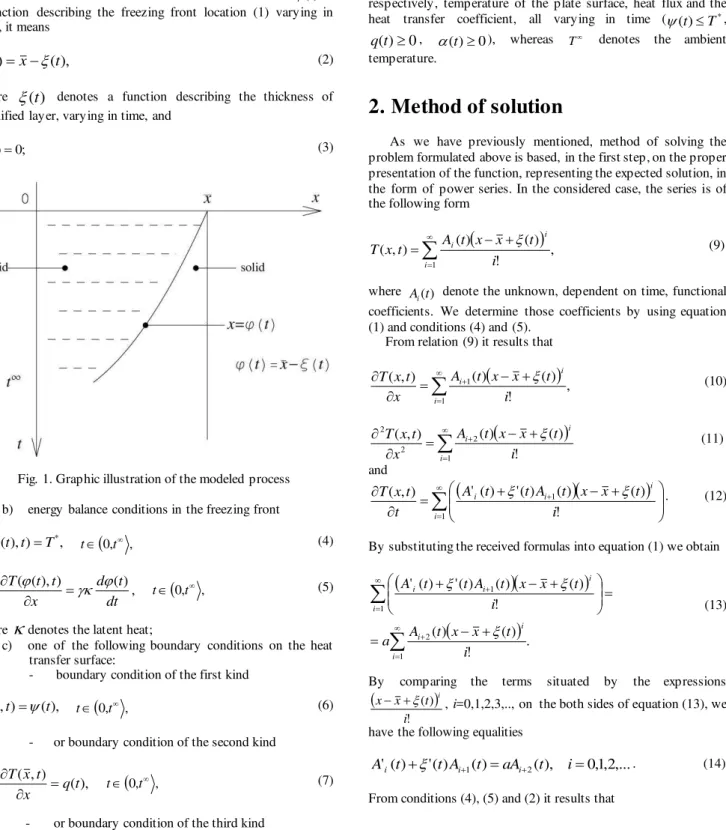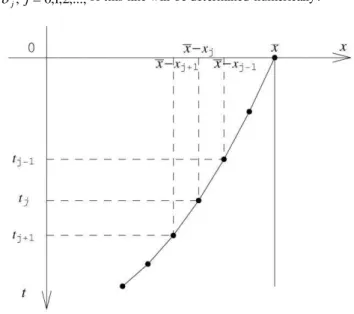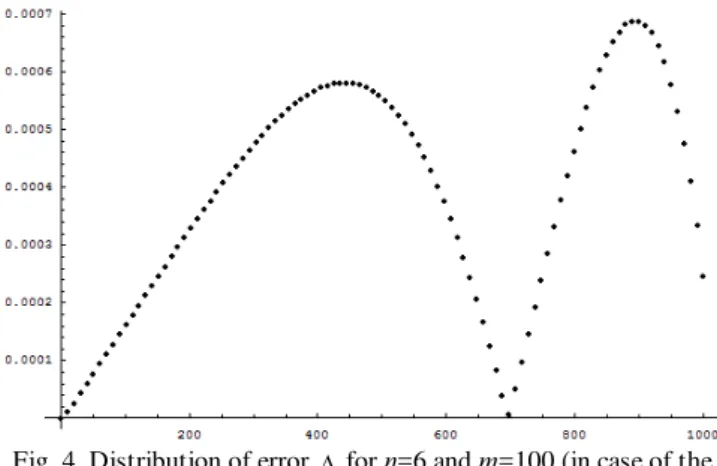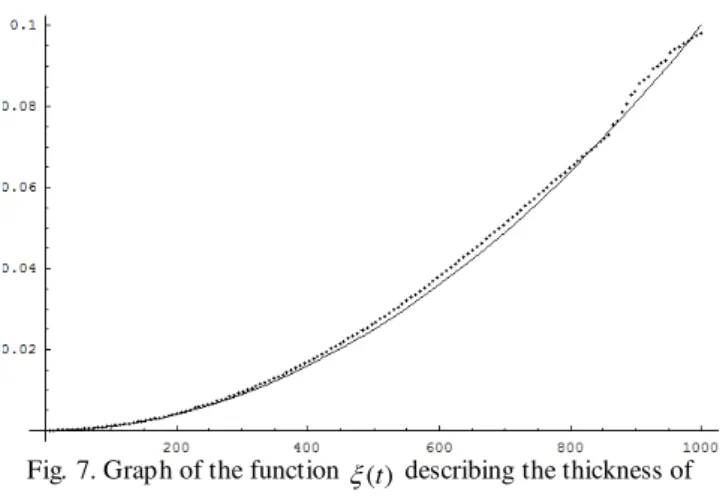A R C H I V E S
o f
F O U N D R Y E N G I N E E R I N G
Published quarterly as the organ of the Foundry Commission of the Polish Academy of Sciences
ISSN (1897-3310) Volume 11 Special Issue
3/2011
75 – 80
14/3
Analytic-numerical method of determining
the freezing front location
R. Grzymkowski, E. Hetmaniok, M. Pleszczyński
*Institute of Mathematics, Silesian University of Technology, Kaszubska 23, 44-100 Gliwice, Poland *Corresponding author. E-mail address: Mariusz.Pleszczynski@polsl.pl
Received 17.06.2011; accepted in revised form 27.07.2011
Abstract
M athematical modeling of thermal processes combined with the reversible phase transitions of type: solid phase – liquid phase leads to formulation of the parabolic boundary problems with the moving boundary. Solution of such defined problem requires, most often, to use sophisticated numerical techniques and far advanced mathematical tools. Excellent illustration of the complexity of considered problems, as well as of the variety of approaches used for finding their solutions, gives the papers [1-4]. In the current paper, the authors present the, especially attractive from the engineer point of view, analytic-numerical method for finding the approximate solution of selected class of problems which can be reduced to the one-phase solidification problem of a plate with the unknown a priori, varying in time boundary of the region in which the solution is sought. Proposed method is based on the known formalism of initial expansion of the sought function describing the temperature field into the power series, some coefficients of which are determined with the aid of boundary co nditions, and on the approximation of the function defining the location of freezing front with the broken line, parameters of which are numerically determined.
Keywords: Solidification process, Application of information technology to the foundry industry, One-phase Stefan problem, M oving boundary problem
1. Introduction
Each correctly defined mathematical model, related to the real problems, requires, at its formulation level, to determine unambiguously the physical determinants of the process concerned by the given model. Taking it into account we initially assume that:
a) temperature of the entire system at the initial moment is equal to the phase transition temperature T* which gives the possibility to assume that the dominant mechanism of heat transfer is the heat conduction,
b) phase transition happens in the strictly determined, constant temperature T* which is typical for the materials of the ideal dielectric properties,
c) material parameters, it means: - mass density, - thermal conductivity and c – specific heat and, from this, the thermal diffusivity coefficient a as well, are independent of temperature and equal in both phases, d) process of the heat transfer is one-dimensional and
symmetric.
Taken assumptions eliminate from the consideration the liquid phase and enable to focus on the solid phase. M athematical model of the problem, formulated in this way (one-phase Stefan problem), is defined by the following system of equations:
, ) , ( ) , ( 2 2 x t x T a t t x T
, , 0 ), ), ( ( t x t t
x (1)
where x denotes the spatial variable, t– time variable,
x
- half of thickness of the plate, t- duration of the process and (t) is a function describing the freezing front location (1) varying in time, it means),
(
)
(
t
x
t
(2)where
(
t
)
denotes a function describing the thickness of solidified layer, varying in time, and; 0 ) 0
(
(3)
Fig. 1. Graphic illustration of the modeled process
b) energy balance conditions in the freezing front
, ) ), (
( t t T*
T
t
0,t, (4) , ) ( ) ), ( ( dt t d x t tT
t
0,t, (5)where
denotes the latent heat;c) one of the following boundary conditions on the heat transfer surface:
- boundary condition of the first kind
), ( ) , (x t t
T
t
0,t , (6)- or boundary condition of the second kind
), ( ) , ( t q x t x T
0, ,t
t (7)
- or boundary condition of the third kind
), ) , ( )( ( ) , (
t T x t T
x t x
T
0, .t
t (8)
In the last equations, functions
(t), q(t) and
(t) describe, respectively, temperature of the plate surface, heat flux and the heat transfer coefficient, all varying in time (
(t)T*,0
)
(
t
q
,
(t)0), whereas T denotes the ambienttemperature.
2. Method of solution
As we have previously mentioned, method of solving the problem formulated above is based, in the first step, on the proper presentation of the function, representing the expected solution, in the form of power series. In the considered case, the series is of the following form
, ! ) ( ) ( ) , ( 1
i i i i t x x t A t xT
(9)where Ai(t) denote the unknown, dependent on time, functional coefficients. We determine those coefficients by using equation (1) and conditions (4) and (5).
From relation (9) it results that
, ! ) ( ) ( ) , ( 1 1
i i i i t x x t A x t xT
(10)
1 2 2 2 ! ) ( ) ( ) , ( i i i i t x x t A x t xT
(11)and
1 1 ! ) ( ) ( ) ( ' ) ( ' ) , ( i i i i i t x x t A t t A t t xT
. (12)By substituting the received formulas into equation (1) we obtain
. ! ) ( ) ( ! ) ( ) ( ) ( ' ) ( ' 1 2 1 1
i i i i i i i i t x x t A a i t x x t A t t A
(13)By comparing the terms situated by the expressions
! ) ( i t xx i , i=0,1,2,3,.., on the both sides of equation (13), we
have the following equalities
,... 2 , 1 , 0 ), ( ) ( ) ( ' ) (
' t t A1 t aA2 t i
Ai
i i . (14), )
( *
0 t T
A (15)
) ( ' )
(
1 t t
A
. (16) Since we have the coefficients A0(t) and
A
1(
t
)
, we candetermine the other coefficients
A
(
t
)
i , i=2,3,4,.., because, by
using formula (14), we have
' () '() ()
, 0,1,2,..., 1)
( 1
2
A t t A t i
a t
Ai i
i (17)which implies that
'()
, )(
A2 t 2
a
t
(18)
'()
, )( '' )
(
A3 2 t 3
a t a
t
(19)
and so on.
Excluding the coefficient A ()
0 t , all the other coefficients )
(
A1 t , i=1,2,3,.., depend on the still unknown function (t), its powers and derivatives. One can try to determine analytically this function by using one of the conditions (6)-(8). In particular, for the condition of the first kind (6) we receive
) ( !
) ( ) (
0
t i
t t A
i
i
i
. (20)
However, equation (20) is as much complicated that determination of the function (t) with the aid of this equation is possible only in case of its certain simplification. Among others, in paper [5] it is presented that by taking only two or three first terms of the series situated on the left side of equation (20) one can find, in some cases, the analytic approximate solution (t) which can be used for estimating the thickness of solidified layer.
Problem of determining the function (t) becomes more complicated if we consider conditions of the second (7) and third (8) kind. For receiving an analytic solution in those cases, some further simplifications must be made in comparison with simplifications necessary in case of the first kind condition.
This approach indicates that regardless of the considered boundary condition, at the end we always receive the approximate solution. The same effect will be achieved if we assume that the function (t), describing position of the freezing front, will be approximated with the aid of the broken line (see Figure 2), it means
), ( )
(t x
t
(21)where
, , 0,1,2,... ,) ( )
(t j ttj xj ttj tj1 j
, (22)
and we take 0, 0,
0
0 x
t tj1tj, j0,1,2,... and
1 1
1( )
j j j j
j t t x
x , j0,1,2,.... Parameters
,..., 2 , 1 , 0 ,j
j
of this line will be determined numerically .
Fig. 2. Approximation of the function describing location of the freezing front
By using the fact below
, , 0,1,2,..., ,) (
't j ttj tj1 j
(23)
from formulas (15) and (16) and the relation (17) we obtain
, , 0,1,2,..., ,,... 2 , 1 , )
( , ) (
1 1
* 0
i t t t j
a t A
T t A
j j i
i j
i
(24)which means that function (9), describing the temperature field in solid phase, can be presented in the following form
, , 0,1,2,...., !
) ) ( (
) , (
1
1 *
j t t t
i x t t x x
a a
T t x T
j j
i
i j j j i
i
j
(25)
Hence, after some simple transformations we receive
, , 0,1,2,...., ) ) ( (
exp )
, (
1 *
j
t t t
a
x t t x x a
a T t x T
j j
j j j
j
(26)
One can easily verify that the function (26) satisfies conditions (4) and (5), and the only unknown elements are the parameters
j, j0,1,2,..., for determination of which will weIf we demand that in every moment of time , 0,1,2,...,
1
j
tj
the boundary condition (6), (7) or (8) is satisfied, we obtain an equation enabling to calculate the sought parameters. In particular, by using boundary condition (6) we have
,.... 2 , 1 , 0 , ) ) ( ( exp 1 )
( * 1
1 j a x t t a T
tj
j
j j j j
(27)By transforming equation (27) we get
,..., 2 , 1 , 0 , 0 ) ( 1 ln ) ( 1 * 1 2 j t T a a x ttj j j j j
j
(28)from which, after including the fact that
j 0,j0,1,2,..., we finally obtain
,.... 2 , 1 , 0 , ) ( 2 ) ( 1 ln ) ( 4 1 1 * 1 2 j t t x t T a t t a x j j j j j j j j
(29)By proceeding in the similar way, we can also determine the forms of function describing position of the freezing front for conditions of the second (7) and third (8) kind. Unfortunately , so far as for condition of the first kind the sought parameters ,
j ,..., 2 , 1 , 0
j are described by means of the explicit relation (29), for conditions of the second and third kind those parameters are defined by equations which cannot be solved analytically. In particular we have
,..., 2 , 1 , 0 ), ( ) ) ( (
exp 1 1
j t q a x t t j j j j j j j
(30)for condition of the second kind and
( )
exp ( ( ) ) ( ) ( ) ,* 1 1 1 a T T t a x t t t a j j j j j j j j ,..., 2 , 1 , 0
j (31)
for condition of the third kind.
After some simple transformations equations (30) and (31) can be presented, respectively, in the following form
,..., 2 , 1 , 0 , ) ) ( ( exp )
( 1 1
j a x t t t
q j j j j j j
j
(32)
,..., 2 , 1 , 0 , ) ) ( ( exp ) ( 1 * 1 j a a x t t a T T
t j j j j j
j j
(33)
and can be solved by applying, for instance, the direct iteration method.
3. Examples
Let us assume that the material of solidified plate of the thickness 2
x
=0,2 [m] is specified by the following parameters: mass density =7000 [kg/m3], thermal conductivity =25 [W/mK], specific heat c=800[J/kgK], latent heat
=247 [kJ/kg], temperature of solidification T*=1500 [K], ambient temperature
T =30 and that the transfer of heat with the environment is
defined by one of the conditions (6)-(8). Additionally, let us assume that we consider the solidification process until the moment of time t=1000 [s].
For the material data, parameters of environment and duration of the process, selected above, it is assumed that the temperature field in solid phase is defined by the function of form (9), on the assumption that () 107 2.
t
t
Function T(x,t), constructed in such a way, satisfies equation (1) and conditions (4) and (5) in the freezing front, position of which is described by means of function (t) of the form
7 2 10 2 . 0 )
(t t
. (34)By having the function determining the temperature field in solid phase, we have generated, by using boundary conditions (6)-(8), the following functions:
(t) describing temperature of the plate surface, q(t) defining density of the flux of heat transferred outside and
(t) denoting the heat transfer coefficient.Functions, determined in such a way, define unambiguously solution of the problem; however, they are given in form of the proper, quickly convergent series. In the testing calculations those series were reduced, from obvious reasons, to the finite number n
of terms. Another important parameter of the procedure indicates the density of discretization of the time variable t. In the paper we assume that the considered time interval *
,
0t is divided into m
equal sections of the length tt*/m which means that
. ,..., 1 , 0
,j m
t j
tj
In the testing calculation the main attention was paid on the precision of reconstruction of the function
(t) describing the thickness of solidified layer, varying in time.3.1. Example 1
Let us consider the case of condition (6) of the first kind. By using formula (29) for the given parameters specifying the discussed problem, for n=6 terms in the proper series and for
Fig. 3. Graph of the function (t) describing the thickness of solidified layer, varying in time (solid line) and its approximation
) (t
(dashed line) calculated for n=6 and m=100 (in case of the boundary condition of the first kind)
In Figure 4 the absolute error of this approximation is displayed. The error is calculated according to the formula
) ( ) ( )
(tj tj tj
, j=1,2,…,m, (35)
where (tj) denotes the absolute error, (tj) is the exact value of function describing the thickness of solidified layer, varying in time, whereas (tj) is its approximate value and tjdesignates the
j-th node of the discretized time variable, j=1,2,…,m.
Fig. 4. Distribution of error for n=6 and m=100 (in case of the boundary condition of the first kind)
3.2. Example 2
Now, let us consider the case of boundary condition (7) of the second kind. By applying formula (32) for the assumed parameters characterizing the discussed problem, for n=5 terms in the proper series and for m=100 nodes of the time interval discretization, we get the result presented in Figure 5.
Fig. 5. Graph of the function (t) describing the thickness of solidified layer, varying in time (solid line) and its approximation
) (t
(dashed line) calculated for n=5 and m=100 (in case of the boundary condition of the second kind
Absolute error of the above approximation is presented in Figure 6.
Fig. 6. Distribution of error for n=5 and m=100 (in case of the boundary condition of the second kind)
3.3. Example 3
Fig. 7. Graph of the function (t) describing the thickness of solidified layer, varying in time (solid line) and its approximation
) (t
(dashed line) calculated for n=4 and m=100 (in case of the boundary condition of the third kind)
In Figure 8 the absolute error of this approximation is showed.
Fig. 8. Distribution of error for n=4 and m=100 (in case of the boundary condition of the third kind)
4. Conclusions
The paper presents the analytic-numerical method of approximate solving the selected kind of problems which can be reduced to the one-phase solidification problem of a plate with the unknown a priori, varying in time boundary of the region in which the solution is sought. Proposed method is based on the expansion of the sought function, describing the temperature field, into the power series, some coefficients of which are determined by using the boundary conditions and on the approximation of the function defining the location of freezing front with the broken line, parameters of which are determined numerically. The presented examples show that for each kind of the boundary conditions the methods gives good results of reconstruction of the function defining position of the freezing front.
References
[1] J.R. Ockendon, W.R. Hodgkins, M oving Boundary Problems in Heat Flow and Diffusion, Clarendon Press, Oxford, 1975. [2] D.G. Wilson, A.D. Solomon, P.T. Boggs, M oving Boundary
Problems, Academic Press, New York, 1978.
[3] J. Crank, Free and M oving Boundary Problems, Clarendon Press, Oxford, 1984.
[4] E. Hetmaniok, D. Słota, R. Wituła, A. Zielonka, Comparison of the Adomian decomposition method and the variational iteration method in solving the moving boundary problem, Computers and M athematics with Applications, vol.61 (2011), 1931-1934.



